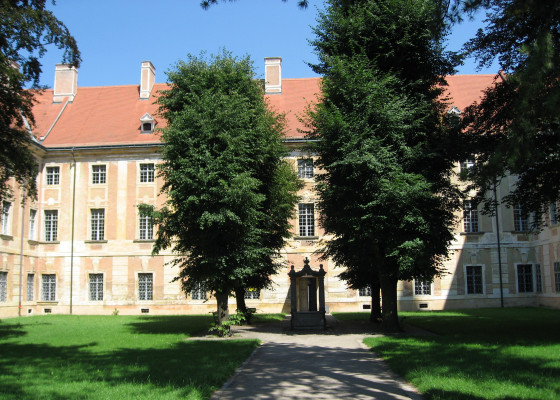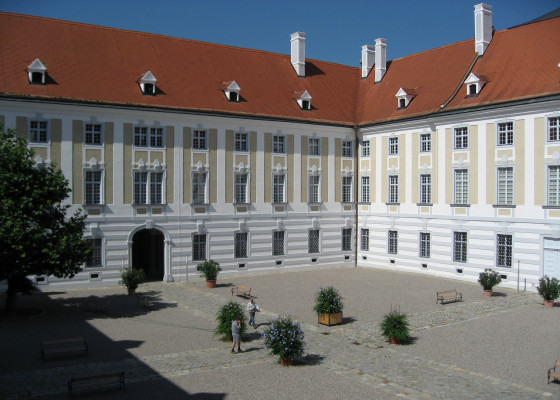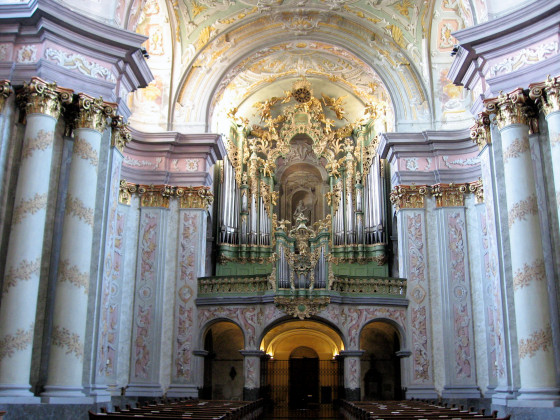In Herzogenburg we took part in a guided tour of the monastery.

Bishop Ulrich I of Passau founded a monastery for Augustinian canons on August 18, 1112, near a church dedicated to St. George on the left bank of the Traisen at the confluence of the Traisen and the Danube.
Under Provost Engelschalk (1242-1267) the monastery was moved to its present location, as the regularly recurring floods of the Danube increasingly transformed the building complex into an island and its foundation walls were threatened with collapse. Herzogenburg was chosen as the new seat of the convent, whose parish was owned by the monastery and which was located at a safe distance from the Danube.
The Gothic monastery survived the centuries, was destroyed several times but always rebuilt. The plague also claimed its victims. In 1541 only one canon and the provost survived.
From 1714 onwards, Herzogenburg Abbey was redesigned in the baroque style by Jakob Prandtauer and Johann Bernhard Fischer von Erlach. Mathias Munggenast completed the tower of the collegiate church in 1767 as the crowning glory.
On this (in the original huge) painting you can see the original gothic Herzogenburg monastery.

Today the monastery appears in baroque garb. Here the outer monastery courtyard.

inner courtyard

hallway on the first floor

a view into the baroque garden

The two-storey Banquet hall was designed by the imperial architect Johann Bernhard Fischer von Erlach. The large ceiling fresco was painted by Bartholomeo Altomonte in 1772 and glorifies Divine Providence, which is effective by the diocese of Passau. Portraits of the bishops of Passau and the provosts of Herzogenburg decorate the walls.

2008 the library was under renovation.

A view into the interior of the collegiate church. The architect was Franz Munggenast. The consecration of the church took place in 1785. It is the last important church building of the baroque in Austria.

One of the showpieces of the Collegiate Church of Herzogenburg is the organ completed by Johann Hencke in 1752, which can be counted among the largest and most important baroque organs in Austria.

Lucas Cranach d. Ä.

At the altar of Mary in the church we find a side-inverted picture of Mariahilf.
To turn the Herzogenburg Maria, move the mouse over the picture.
According to the legend, this picture of the Virgin Mary is said to come from Hungary. The imperial courier Michael Molinari de Pallo is said to have been mysteriously saved from his misery by this picture. Through his son Ferdinand, who later joined Herzogenburg Abbey, the picture of the Virgin Mary reached the Abbey Church in 1680, where it was highly venerated as an image of grace and pilgrimage.
If you look at the Herzogenburg Marian picture side-inverted, it cannot deny a certain similarity with the Mariahilfbild (Mary help picture) by Lucas Cranach.
Traisen upwards in the
there is another copy of this Mariahilf picture in the church.

During the guided tour you will also visit the monastery museum.
This cross ("mystic crucifix") from the early 14th century (around 1310) comes from the castle chapel of Unterradlberg near Herzogenburg.
A chest capsule was intended for a cross relic which got lost.

In the gothic collection of the monastery there are many treasures, mostly works of the 'Donauschule'.

After the interesting visit to the monastery we met with friends at a Heurigen in the Traisental valley near Herzogenburg.
This was the nice ending of our first hiking days on the Austrian Jakobsweg (way of St. James).

